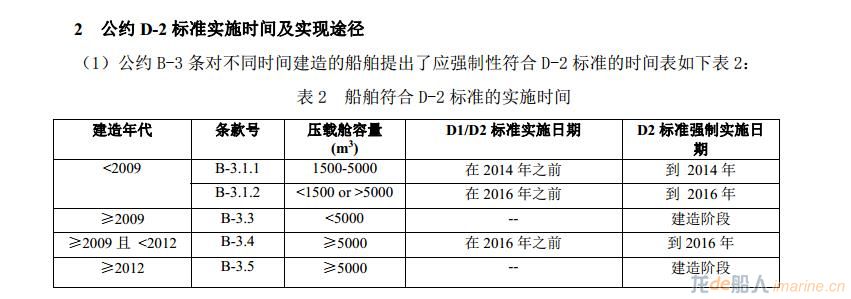大家可能也知道,按照IMO的最新规则状态,2017 年9月8号压载水处理公约就进入强制生效,对2012以后建造的船舶需要满足D2压载水处理性能标准。 看公约文字主要说ship没提到offshore这块,大家来讨论一下这个适用于JACK-UP吗,或者放大适用offshore这块吗?摘抄IMO CONVENTION原文和CCS的压载水公约实施指南:
Annex - Section B Management and Co***ol Requirements for Ships
Ships are required to have on board and implement a Ballast Water Management Plan approved by the Administration (Regulation B-1). The Ballast Water Management Plan is specific to each ship and includes a detailed description of the actions to be taken to implement the Ballast Water Management requirements and supplemental Ballast Water Management practices.
Ships must have a Ballast Water Record Book (Regulation B-2) to record when ballast water is taken on board; circulated or treated for Ballast Water Management purposes; and discharged into the sea. It should also record when Ballast Water is discharged to a reception facility and accidental or other exceptional discharges of Ballast Water
The specific requirements for ballast water management are contained in regulation B-3 Ballast Water Management for Ships:
Ships constructed before 2009 with a ballast water capacity of between 1500 and 5000 cubic metres must conduct ballast water management that at least meets the ballast water exchange standards or the ballast water performance standards until 2014, after which time it shall at least meet the ballast water performance standard.
Ships constructed before 2009 with a ballast water capacity of less than 1500 or greater than 5000 cubic metres must conduct ballast water management that at least meets the ballast water exchange standards or the ballast water performance standards until 2016, after which time it shall at least meet the ballast water performance standard.
Ships constructed in or after 2009 with a ballast water capacity of less than 5000 cubic metres must conduct ballast water management that at least meets the ballast water performance standard.
Ships constructed in or after 2009 but before 2012, with a ballast water capacity of 5000 cubic metres or more shall conduct ballast water management that at least meets the standard described in regulation D-1 or D-2 until 2016 and at least the ballast water performance standard after 2016.
Ships constructed in or after 2012, with a ballast water capacity of 5000 cubic metres or more shall conduct ballast water management that at least meets the ballast water performance standard.
Other methods of ballast water management may also be accepted as alternatives to the ballast water exchange standard and ballast water performance standard, provided that such methods ensure at least the same level of protection to the environment, human health, property or resources, and are approved in principle by IMO's Marine Environment Protection Committee (MEPC).
Under Regulation B-4 Ballast Water Exchange, all ships using ballast water exchange should:
whenever possible, conduct ballast water exchange at least 200 nautical miles from the nearest land and in water at least 200 metres in depth, taking into account Guidelines developed by IMO;
in cases where the ship is unable to conduct ballast water exchange as above, this should be as far from the nearest land as possible, and in all cases at least 50 nautical miles from the nearest land and in water at least 200 metres in depth.
When these requirements cannot be met areas may be designated where ships can conduct ballast water exchange. All ships shall remove and dispose of sediments from spaces designated to carry ballast water in accordance with the provisions of the ships' ballast water management plan (Regulation B-4).
中国船级社- 压载水处理公约实施指南2015
 -->
-->
三、 IMO 临时解决方案
1 D-2 标准实施日期
为使压载水公约尽快达到生效条件,解决公约B-3条规定的船舶应强制性符合D-2标准的时间表
的法律有效性问题,IMO在第28届大会(A28)上以A.1088(28)决议通过了“2004年国际压载水及其
沉积物控制和管理公约实施”,对D-2标准实施日期给予重新规划,以此鼓励IMO成员国尽快批准加入
压载水公约,并可根据该决议给出的时间表实施。
 -->
-->
注2:如果公约在2016年及以后生效,在公约生效日期后的首次换证检验时满足D-2标准。
A.1088(28)决议同时规定,上表3中的“换证检验”与MARPOL附则I中的IOPP证书的换证检验相
协调。船东可根据船舶的IOPP证书计划换证检验窗口选择合适的压载水证书的换证检验时间,以此
合理安排船舶安装压载水管理系统,避免压载水公约生效后船舶集中检验发证的问题
二、压载水公约实施存在的困难
1 D-2 标准实施日期
公约 B-3 条规定了船舶应强制性符合 D-2 标准的时间表,由于公约没有生效,该实施日期并不
具法律效力。 由于压载水公约在生效前不能够对其进行修订, D-2 标准实施时间表的执行成为问题。
2 船舶检验发证
压载水公约对公约生效前建造的船舶的符合日期没有任何缓冲期,也就是税,一旦公约生效,
所有公约适用的船舶均应持有有效的压载水管理证书才能营运。假定在 2016 年内公约能生效实施,
预计在 2016 年至 2021 年间将有超过 70000 艘船舶需要安装 BWMS,到时修船厂的安装能力及生产厂
家的产能都会有限。对于公约生效前已经投入运营的船舶而言,这意味着在公约生效前船舶应已经
检验发证并持有证书才不至于到公约生效之日因没有证书而被迫停运。 然而按照 IMO 公约如 SOLAS、
MARPOL 以往的做法,在公约生效前主管机关是不能签发证书的,如果提前实施也只是签发《符合证
明》。但对于压载水公约而言,即使先签发《符合证明》,在公约到达生效条件之日至生效之日间的
12 个月内,对目前全球营运的约 75000 艘适用范围内的船舶完成证书换发也是不现实的。
|